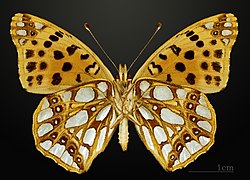Small mother-of-pearl butterfly
| Small mother-of-pearl butterfly | ||||||||||||
|---|---|---|---|---|---|---|---|---|---|---|---|---|

Small mother-of-pearl butterfly ( Issoria lathonia ) |
||||||||||||
| Systematics | ||||||||||||
|
||||||||||||
| Scientific name | ||||||||||||
| Issoria lathonia | ||||||||||||
| ( Linnaeus , 1758) |
The little mother-of-pearl butterfly , or little mother-of-pearl butterfly , ( Issoria lathonia , syn .: Argynnis lathonia ) is a butterfly (day butterfly ) from the family of the noble butterfly (Nymphalidae). The specific epithet is derived from Lathonia, an epithet of Artemis from Greek mythology .
features
The moths reach a wingspan of 35 to 45 millimeters. They have yellow-red wing tops that have an almost even pattern of rounded, black spots. The undersides of the wings are yellow-brown and have very large, white mother-of-pearl spots. In addition to the outer row of these spots on the hind wing, a regular row of very small, white spots can be seen, which are outlined in dark brown and further out in light brown. On the wing tips of the forewings there are also, only smaller, mother-of-pearl spots and a beginning of a similar brown band with dots as on the hind wings.
The caterpillars are about 35 millimeters long. They are gray-brown and have black spots. On the back they have a double row of white lines lying close together. They have yellow-brown thorns that turn white towards the tip and are somewhat fringed.
Occurrence
They are widespread and still common in Central Europe , but their populations are declining in places . They live in loosely overgrown terrain such as B. dry grassland , fallow land and also extensively used cultivated areas.
Way of life
The moths fly over a very long period from April to October and produce up to three, sometimes even four generations a year. In addition, specimens that have immigrated from the south can be found in Central Europe. The moths like to sunbathe in bare spots on the ground, especially on cool days in spring and autumn.
Food of the caterpillars
The caterpillars feed on the leaves of the field pansy ( Viola arvensis ), but also eat garden pansies ( Viola x wittrockiana ) during breeding .
development
The females lay their eggs individually on the underside of the leaves of the forage plants or on other plants in their vicinity. The caterpillars only need a short time for their development and pupate near the ground between loosely spun plant parts as a tumbler . This has several white spots so that the pupa resembles bird droppings . The species overwinters as a caterpillar.
Hazard and protection
The caterpillar lives mainly on fields or their edges and is therefore endangered by more intensive cultivation. The hazards exist e.g. B. from the upheaval immediately after the harvest and the associated destruction of pansies, the use of sprays and land consolidation measures that destroy the field edge areas such as embankments, field edges and paths. In particular, the application of total herbicides, which has increased extremely since the turn of the millennium, harms the species.
The species is not included in the Red List of Threatened Species in Germany, but is listed as "critically endangered" (Category 2) in the list for Baden-Württemberg and as "Endangered" (Category 3) in the list for Hamburg.
swell
Individual evidence
- ↑ Elizabeth Balmer: Butterflies: Recognize and Determine. Parragon Books, 2007, ISBN 9781407512037 , p. 130
- ^ Arnold Spuler: The butterflies of Europe . tape 1 . E. Schweitzerbartsche Verlagbuchhandlung, Stuttgart 1908, p. 29 .
- ↑ a b W. Düring: Small mother-of-pearl butterfly. In: Butterfly in Rhineland-Palatinate. BUND RLP, January 5, 2020, accessed on April 17, 2020 (German).
- ↑ Günter Ebert, Erwin Rennwald (ed.): The butterflies of Baden-Württemberg. Volume 1, Butterfly I (Knight's Butterfly (Papilionidae), Whiteflies (Pieridae), Edelfalter (Nymphalidae)). Ulmer Verlag, Stuttgart 1993, ISBN 3-8001-3451-9 .
- ↑ Butterflies of Germany, online http://www.schmetterlinge-deutschlands.de/verbindungenfam.php?fam=Nymphalidae&erster=7210 (accessed on January 16, 2013)
literature
- Heiko Bellmann : The new Kosmos butterfly guide. Butterflies, caterpillars and forage plants. Franckh-Kosmos, Stuttgart 2003, ISBN 3-440-09330-1 .
- Tom Tolman, Richard Lewington: The butterflies of Europe and Northwest Africa. Franckh-Kosmos Verlags-GmbH & Co, Stuttgart 1998, ISBN 3-440-07573-7 .
- Hans-Josef Weidemann: Butterflies: observe, determine. Naturbuch-Verlag, Augsburg 1995, ISBN 3-89440-115-X .
Web links
- Lepiforum e. V. Taxonomy and Photos
- Issoria (Issoria) lathonia at Fauna Europaea
- www.schmetterling-raupe.de
- Species portraits of butterflies in Rhineland-Palatinate - Small mother-of-pearl butterfly
- Heiner Ziegler: Butterflies of Switzerland
- Moths and Butterflies of Europe and North Africa (English)




